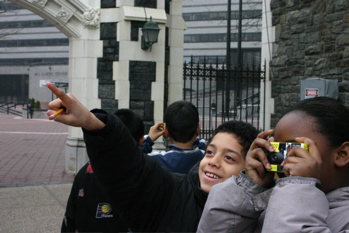by Catherine Teegarden Center for Architecture Foundation
The Center for Architecture Foundation recently hosted Chris Whitwood, a British graduate student from York St. John’s University, for a two-week international placement as part of his program in primary school education. This cross-cultural experience provided both CFAF and the student with an opportunity to compare notes on teaching and to take a fresh look at our own practices. Whitwood’s undergraduate degree in product design made him a good match for CFAF’s design-based programs, and he participated in several, including Student Day workshops for school groups visiting the Center, Learning By Design:NY in-school residency programs, and a teacher training session.
Some of the most interesting areas of comparison were our curriculum standards, particularly the place of design education in each curriculum. The English National Curriculum has a distinct requirement for teaching Design and Technology beginning in the earliest primary grades. The curriculum stipulates that students are expected to design, make, and evaluate “purposeful, functional, appealing products for themselves and other users,” and to “build structures, exploring how they can be made stronger, stiffer, and more stable.” As they grow older, these projects incorporate more complicated technology, such as gears, electricity, and computer programs. The goals are to ensure that all pupils “develop the creative, technical and practical expertise needed to perform everyday tasks confidently and to participate successfully in an increasingly technological world.”
In the U.S., “technology education,” as it is called, varies from state to state and is not a national requirement. New York State has one of the more robust technology requirements in the nation, but it is only a strand of the state’s Math, Science & Technology standards, rather than a stand-alone requirement. The NY State Education Department defines technology education as using “concepts of science, mathematics, social science, and language arts in a hands-on, systems-based approach to problem solving that guides students in the understanding, design, and development of systems, devices, and products to serve human needs and wants.” Yes, you probably have to re-read that sentence to get at what they are saying, and it is neither as straightforward nor as far-reaching as the English definition. NY State standards present this topic as an opportunity for students to “apply their mathematics and science skills” and explore “technology-related careers.” Rather than being an area of study considered essential for successful participation in everyday life, as the English model suggests, the NY State Standards pose design as a specialized field that demonstrates the practical applications of a geometry or physics lesson, but not something that is an integral part of everyone’s daily life.
Of course, design does influence every aspect of our lives, from the streets and buildings in which we live to the products, systems, and information we use to manage our lives. In this regard, the English model seems more honest, more relevant, and frankly, more fun. Whitwood related an astounding story of a class studying the Great Fire of London (1666) in which the students re-enacted the conflagration in their schoolyard using building models they had made for the purpose, giving them a concrete – and highly memorable – understanding of the fire’s quick spread and its devastating effect on the city. While this is not an everyday lesson in anyone’s plan book, this compelling activity resonated as a reminder that learning experiences that actively engage students and connect to their own lives are the ones that motivate students to ask questions about the world around them, and thus engender lifelong learning.
Will the English become more thoughtful or critical about design in their daily lives as a result of this curricular mandate? Time will tell, but in any case, it reveals a belief that design affects everyone, and thus should be part of everyone’s basic education. The Center for Architecture Foundation shares this belief and continues to advocate for built-environment education as a fundamental area of study, especially for children in New York City. Since our curriculum standards do not mandate this, however, we must first prove to schools that our architecture and design-based programs will help them meet state standards, and provide concrete, hands-on learning that links classroom studies to the real world. They do, but this is only part of our motivation.
We invite anyone interested in seeing what students gain from learning about the built environment to join us for 3rd – 8th grade students’ presentations of their skyscraper designs at the end of CFAF’s 3-day vacation programs on Skyscrapers on 03.20.14 from 3:15 – 4 pm at the Center. Young people who wish to explore this topic themselves can still register for our April Skyscrapers program during the public school spring break. For more information, please contact us at info@cfafoundation.org.
